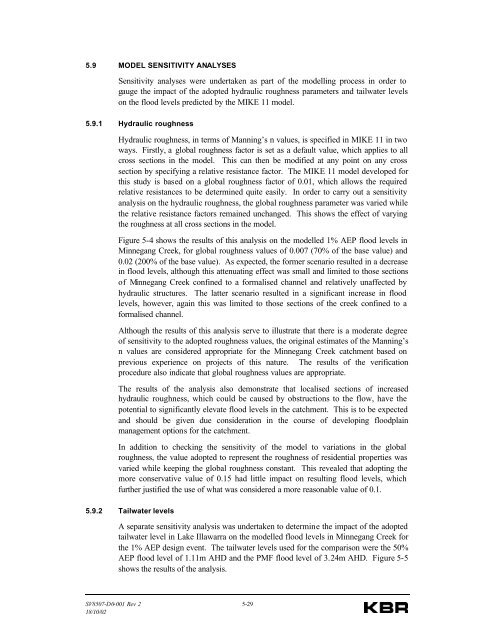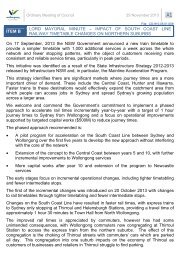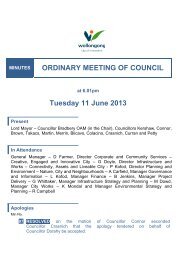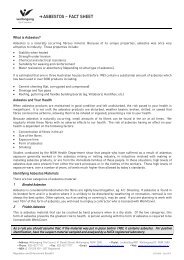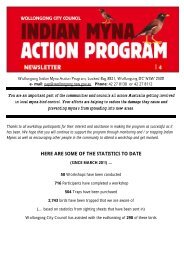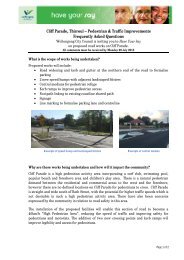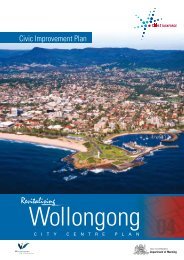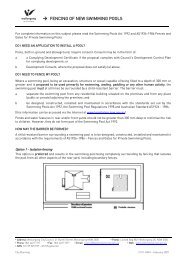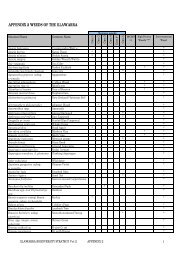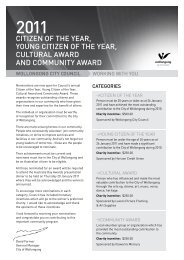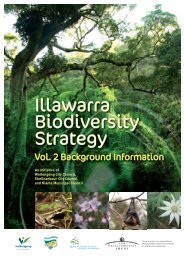Minnegang Creek Flood Study Report - Wollongong City Council
Minnegang Creek Flood Study Report - Wollongong City Council
Minnegang Creek Flood Study Report - Wollongong City Council
- No tags were found...
Create successful ePaper yourself
Turn your PDF publications into a flip-book with our unique Google optimized e-Paper software.
5.9 MODEL SENSITIVITY ANALYSESSensitivity analyses were undertaken as part of the modelling process in order togauge the impact of the adopted hydraulic roughness parameters and tailwater levelson the flood levels predicted by the MIKE 11 model.5.9.1 Hydraulic roughnessHydraulic roughness, in terms of Manning’s n values, is specified in MIKE 11 in twoways. Firstly, a global roughness factor is set as a default value, which applies to allcross sections in the model. This can then be modified at any point on any crosssection by specifying a relative resistance factor. The MIKE 11 model developed forthis study is based on a global roughness factor of 0.01, which allows the requiredrelative resistances to be determined quite easily. In order to carry out a sensitivityanalysis on the hydraulic roughness, the global roughness parameter was varied whilethe relative resistance factors remained unchanged. This shows the effect of varyingthe roughness at all cross sections in the model.Figure 5-4 shows the results of this analysis on the modelled 1% AEP flood levels in<strong>Minnegang</strong> <strong>Creek</strong>, for global roughness values of 0.007 (70% of the base value) and0.02 (200% of the base value). As expected, the former scenario resulted in a decreasein flood levels, although this attenuating effect was small and limited to those sectionsof <strong>Minnegang</strong> <strong>Creek</strong> confined to a formalised channel and relatively unaffected byhydraulic structures. The latter scenario resulted in a significant increase in floodlevels, however, again this was limited to those sections of the creek confined to aformalised channel.Although the results of this analysis serve to illustrate that there is a moderate degreeof sensitivity to the adopted roughness values, the original estimates of the Manning’sn values are considered appropriate for the <strong>Minnegang</strong> <strong>Creek</strong> catchment based onprevious experience on projects of this nature. The results of the verificationprocedure also indicate that global roughness values are appropriate.The results of the analysis also demonstrate that localised sections of increasedhydraulic roughness, which could be caused by obstructions to the flow, have thepotential to significantly elevate flood levels in the catchment. This is to be expectedand should be given due consideration in the course of developing floodplainmanagement options for the catchment.In addition to checking the sensitivity of the model to variations in the globalroughness, the value adopted to represent the roughness of residential properties wasvaried while keeping the global roughness constant. This revealed that adopting themore conservative value of 0.15 had little impact on resulting flood levels, whichfurther justified the use of what was considered a more reasonable value of 0.1.5.9.2 Tailwater levelsA separate sensitivity analysis was undertaken to determine the impact of the adoptedtailwater level in Lake Illawarra on the modelled flood levels in <strong>Minnegang</strong> <strong>Creek</strong> forthe 1% AEP design event. The tailwater levels used for the comparison were the 50%AEP flood level of 1.11m AHD and the PMF flood level of 3.24m AHD. Figure 5-5shows the results of the analysis.SV8507-D0-001 Rev 2 5-2918/10/02


